2. 北京工业大学建筑工程学院, 北京 100124;
3. 中国地震局地球物理研究所, 北京 100081
2. College of Architecture and Civil Engineering, Beijing University of Technology, Beijing 100124, China;
3. Institute of Geophysics, China Earthquake Administration, Beijing 100081, China
在板块俯冲过程中发生的水分运移,主要包括板块的水化以及水分随着俯冲板块深入到地幔中,并由脱水作用析出,从而影响地幔物质的整个过程.众所周知,流体(水)对地质体的地球物理性质、地质灾害诱发、地质构造演化等都有着重要的作用,这种作用不仅表现在岩石圈,而且可以深入到地幔中(Worzewski et al., 2011;Nakajima et al., 2011),甚至可深达地幔~600多公里处(Sheng et al., 2016;Zhao and Ohtani, 2009;Faccenda,2014).流体(水)推动着整个地球动力演化过程,因为其可以降低岩石圈以及地幔物质的固液相限(Peacock, 1990a, 1990b)和提高地质体的扩散及蠕变(Mei and Kohlstedt, 2000a,2000b).在俯冲带,岩石/地幔固液相限的降低可以使得地幔楔中热的部分产生地幔熔融,甚至也可以帮助在例如俯冲板块上部相对温度较低的部位也产生熔融(Liao et al., 2017).这些熔融物质是整个动力学演化中的重要因素,同时是火山岛弧产生的主要原因,也是弧后盆地形成的关键因素.俯冲板块在浅部脱水形成的地幔熔融物质,部分上涌后进入到弧后区域内,可以进一步促进弧后盆地的演化.板块在深部(例如西太平板块平卧在亚欧板块下方~660 km处)的脱水为湿地幔羽的上涌(van der Lee et al., 2008)以及内陆火山的成因都提供了较为合理的解释(Zhao and Ohtani, 2009;Sheng et al., 2016;马晗瑞,2016).
在板块俯冲区,流体/水分的影响贯穿了整个动力学过程.目前,板块在浅(中)部(上地幔)脱水(约200 km深度范围内)已经获得了相对较为完善和可靠的证据(Worzewski et al., 2011;Nakajima et al., 2011).虽然有人认为水分不可能在高温-高压条件下被板块带入到地幔深部.但越来越多的研究(Sheng et al., 2016;Faccenda,2014;Ohtani et al., 2014)显示板块是有能力将水分带入地幔深部的.如上所述,水分在板块俯冲过程中有着重要的作用,然而目前大部分研究都主要集中在浅(中)部脱水(Worzewski et al., 2011;Nakajima et al., 2011)或深部脱水(Sheng et al., 2016;Faccenda,2014;盛俭等,2018).对于水分在整个俯冲中的连续过程以及地球物理作用的系统研究还较少,本文研究的目的在于利用地球动力学数值模型模拟板块的俯冲,将研究的重点放在流体/水分的迁移过程,并探讨其地球物理含义.
1 计算模型 1.1 基本设置本文要考虑整个俯冲过程中水分的运移过程,因此在模型垂直方向上要设置足够的深度,以满足分析俯冲板块深部脱水的要求.在模型水平方向上对弧后扩展的完整性考虑也需要设置较大尺寸(图 1).模型采用了非均匀的网格划分方式,俯冲带附近采用了较高的划分精度,纵、横向精度由两侧的5 km×5 km提升至俯冲带附近的1 km×1 km.如图 1所示,模型的设计主要参照了一般俯冲带的基本特征(Turcotte and Schubert, 2002),为了可以使俯冲板块水化,在其上方设置了厚4 km的黏性水层(Crameri et al., 2012).同时,为了保证板块顺利地俯冲,在两个板块交界的地方设置了沉积楔和软弱带,这是在进行俯冲带地球动力学数值模拟时一种常用的方法(Gerya and Meilick, 2011;Baitsch-Ghirardello et al., 2014;盛俭等,2018).由于要考虑底部物质运移的影响,因此在底部设置了一个水平向可自由滑动的垂直渗透边界,其余三边设置了自由滑动边界(Sheng et al., 2016;盛俭等,2018;Baumann et al., 2010;马晗瑞,2016).整个模型的温度场由半空间冷却模型控制(Turcotte and Schubert, 2002).模型初期(10 Ma)的板块汇聚速率为30 mm·a-1,之后模型进入自我演化过程.地壳和地幔中相变的密度效应是基于地壳和地幔中最重要矿物反应的P-T条件以一种简化的方式实现的(Mishin et al., 2008;Sheng et al., 2016).

|
图 1 数值模型初始设置示意图 Fig. 1 Initial model geometry |
对于数值模拟来说,模型参数正确与否起着决定性作用.在模型参数确定时,参考了大量前人的数据.Turcotte和Schubert(2002)、Bittner和Schmeling(1995)对俯冲带物质的地球物理介质参数进行了包括物质的固态及熔融态密度(ρ0)、潜在热量(QL)、热容(Cp)、热膨胀率(α)、收缩率(β)等的研究.Ranalli(1995)给出了俯冲带物质的黏聚力(c0)和有效内摩擦角(sinφdry),模型中采用了这些已经被广泛认可的参数(Gerya and Meilick, 2011;Baitsch-Ghirardello et al., 2014;盛俭等,2018;马晗瑞,2016),模型中涉及的其他一些参数也参考了前人通过模拟试验所验证(Sheng et al., 2016;马晗瑞,2016)的研究成果,见表 1.
|
|
表 1 模型地球物理介质参数表 Table 1 Material geophysical properties used in the model |
模型中水分在俯冲板块中的析出主要包括孔隙压缩排水和脱水过程两部分:
(1) 孔隙压缩排水主要通过深度进行控制(Vogt et al., 2012):

|
(1) |
式中,XH2O0是地表水分的质量百分比;Δy是深度(0~75 km).这个过程主要是由于随着深度增加而压力增大引起的空隙压缩排水(Wang and Zhao, 2005;Wang and Zhao, 2006;Wang et al., 2019),排出含水量为1.4~4 wt.%的水化基性岩中的水分(Vogt et al., 2012).
(2) 水化和脱水过程中的水分运移主要受控于温-压(P-T)条件,以及水分的稳定平衡(≤2wt.%H2O).是基于地球物理-化学条件以及热动力学平衡假设来计算的(Gerya and Meilick, 2011;Vogt et al., 2012),利用Perple_X(Connolly,2005;2009)作为一个函数嵌入到我们的模型中,通过P-T条件控制水分运移,例如沉积物含水量的P-T条件是Pmax=7 GPa和T=1500 ℃,因为沉积物一般不能下沉到更深的地幔中.相比之下,洋壳和地幔物质含水量的P-T条件设置到30 GPa,也就是下地幔的深度,这样可以模拟包括MTZ在内的整个上地幔及下地幔上层的水分转化(Li et al., 2019).在计算过程中通过追踪每个时步的P-T变化,从而确定各岩石类型的含水量,最终由拉格朗日水分平流点来实现,这些水分平流点独立向上迁移,直到被水化或被部分熔融作用消耗(0 wt.%H2O)(Gerya and Yuen, 2003,2007;Gorczyk et al., 2007;盛俭等,2018;Li et al., 2019;Wang et al., 2018;2019).模型控制熔融过程所采用的方程,同时考虑了压力、温度、水分含量及矿物熔融特征(Katz et al., 2003).
2.2 水分运移的三个阶段岩石圈水化的主要机制是海水渗流到干的基性岩和超基性岩中,随着含水板块在负浮力的作用下发生俯冲,大部分的板块在中(浅)部深度(< 300 km)发生脱水并导致地幔岩石发生部分熔融(石耀霖和张健, 1998, 2004;Vogt et al., 2012, 2013),造成显著的岩浆作用并生成火山岛弧,对地幔对流及其波速等产生影响(Faccenda,2014).板块深部脱水(>300 km)虽然还有争议,但越来越多的研究认为渗透板块有能力将水分传送到下地幔,并在俯冲带深部发生脱水作用(Richard et al., 2006;Sheng et al., 2016;马晗瑞,2016).
在系统分析模拟结果的基础上,发现可以将水分在板块俯冲中的运移分为3个主要阶段:洋壳的水化阶段、板块中(浅)部脱水阶段、板块深部脱水阶段.
(1) 洋壳水化
洋壳的水化很大一部分是在洋中脊附近完成的.为了考虑该部分的水化作用,在模型中定义洋壳的顶部为一层厚7 km的均匀水化基性岩,其中玄武岩厚2 km,辉长岩厚5 km,其含水量分别为4 wt.%和1.4 wt.%.模型中洋壳(俯冲板块)的水化过程主要是水分通过由于俯冲导致板块弯曲形成的张性断裂或裂缝渗流/渗透到深部的干镁铁质和超镁铁质的岩石中.这种过程在一定程度上是相互促进的,张性断裂的发育使得水化更充分,水化过程反过来促进断裂的发育(图 2).蛇纹石化是俯冲带另一个重要的洋壳水化方式,发生在板块内部,在较老的板块中被观测到可以发育到40 km的深度(Li and Lee, 2006),因此可以将水分保存在洋壳的内部.随着俯冲,洋壳内部的温度受外部地幔物质加热而上升的速度要慢于外部,导致其脱水作用发生较晚(English et al., 2003),这被认为是一种保证水分进入地幔更深处的有效机制(Li et al., 2008).模型中蛇纹石化的程度是根据地震层析成像等观测数据(Ivandic et al., 2010;Contreras-Reyes et al., 2011;van Avendonk et al., 2011)的平均值(10~20 km)进行设置的,岩石圈地幔在这一深度范围内的物质超过一个脆性阀值(如εserp=0.05)将转换为15%蛇纹石化的岩石(2 wt.% H2O)(图 2).
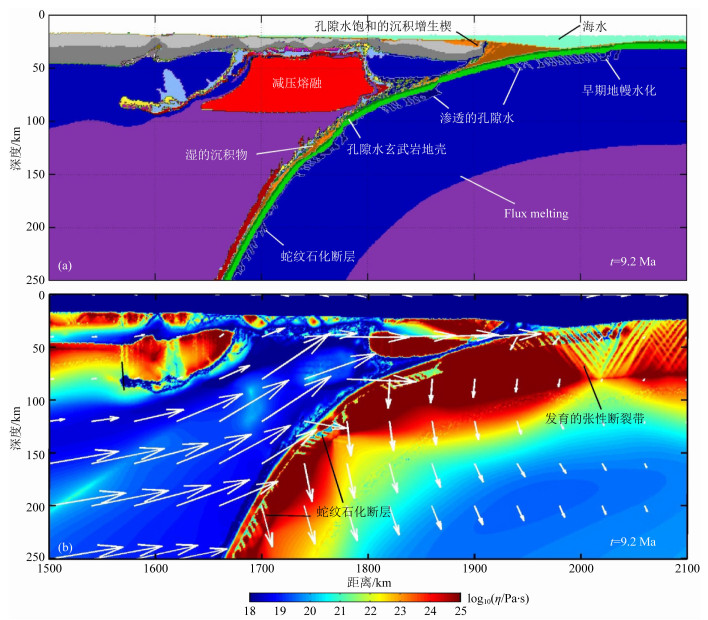
|
图 2 模型在9.2 Ma时的成分场及黏度场的部分截图(注:图中白色箭头代表速度) Fig. 2 Partial screenshot of component field and viscosity field of the model at 9.2 Ma |
(2) 板块浅(中)部脱水
密度大且温度低的水化洋壳在俯冲过程中与地幔楔摩擦生热以及被其传导加热,当温度持续升高到一定程度时,其内部的矿物(如角闪石等)释放水分的过程是板块浅(中)部(< 300 km)脱水的主要机制,目前已经被越来越多的地球物理方法观测到(Worzewski et al., 2011;Nakajima et al., 2011).这些水分扩散到地幔楔内,降低了地幔物质的熔点,使其固液相限与所处地温线相交而产生部分熔融及岩浆作用,在地表上表现为形成火山岛弧.脱水量的不断增多,伴随着岩石圈地幔的伸展而上升,引起上覆大陆板块的地壳减薄,在地表形成了新的火山地壳.根据研究,这种脱水大部分发生在洋壳俯冲到60~150 km左右的深度(石耀霖和张健, 1998, 2004;Vogt et al., 2012, 2013),如西南日本的菲律宾板带主要发生在60~100 km,而东北日本的太平洋俯冲带(老并且冷的俯冲板块)脱水深度达到了120~150 km.俯冲带角度也可能会对这一深度造成一定的影响,但一般不会超过200 km.当橄榄岩(地幔物质)中含有少量(< 1~2%)的流体或熔融物质时,其地震波传播速度将显著降低(Thybo,1997;Karato,1998).因而地震层析成像等观测方法(Zhao et al., 2004;Zhao and Tian, 2013)观测到的板块上方浅(中)部地幔楔中存在的地震波低速带,被认为是浅(中)部脱水和部分熔融的间接证据.
(3) 板块深部脱水
尽管水分的存在会促进地幔岩石部分熔融,但根据瑞利-泰勒不稳定性,密度小的水分会向上运移而不能影响地幔深部,使得熔融作用也往往主要发生在岩石圈底部(Richard and Iwamori, 2010).俯冲板块是否有能力发生深部脱水,板块所携带的水分含量、水分在俯冲板块中的溶解度和扩散率均是重要参数.模型中设置初始俯冲板块的洋壳由2 km厚的饱水玄武岩(4 wt.%H2O)以及5 km厚的辉长石(1.4 wt.%H2O)组成,洋壳下方设置为干的软流圈物质,地幔物质则设为干的橄榄岩,含水及脱水过程中水分运移均自由演化.
水化的板块(>1 wt.%H2O)俯冲到地幔深部,致密含水镁质硅酸盐(DHMS)通过一系列的转换(A-H相)(Ohtani et al., 2014),阻止相对温度较低的板块内部的脱水作用.另外,蛇纹石化在板块内部储水,受地幔加热作用缓慢,脱水作用发生较晚,这些可以使板块携带的水分在浅(中)部并没有完全被消耗掉.从图 3a可以看到,大约0.4~0.8 wt.%的水分可以运移到地幔深部,到达~660 km的相变面附近.板块俯冲到平卧阶段,平卧的板块被逐渐加热使其内部开始发生脱水作用而析出更多水分,这些水分由于向上迁移使得洋壳上部再次被水化(0.4~0.6 wt.%),甚至可以达到~0.9 wt.%H2O(图 3b).洋壳内部脱水所析出的水分中不能被本身水化过程及部分熔融作用所消耗掉的部分,将上浮并湿润板块上部的地幔楔(图 3c).这部分没有消耗的水分如果足够多,甚至可以运移0.4~0.5 wt.%的水分到大陆板块下方(图 3d),这些水分将造成大陆板块下方的部分熔融并形成岩浆房(Sheng et al., 2016;Zhao and Ohtani, 2009;Faccenda,2014;盛俭等,2018).
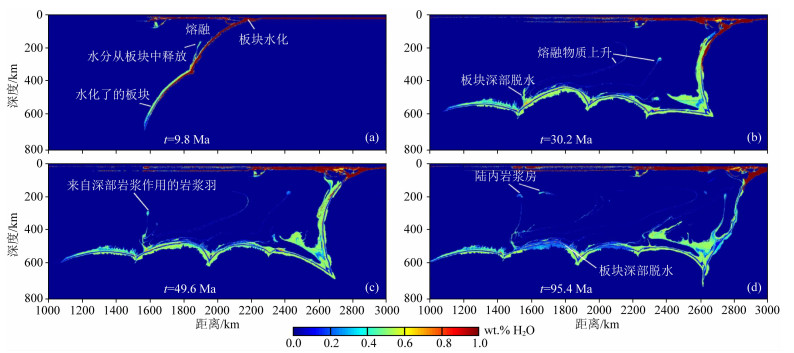
|
图 3 不同时刻模型水分运移质量百分比(wt.% H2O)示意图(盛俭等,2018) Fig. 3 Water transport mass ratio of model at different times (wt.% H2O)(Sheng et al., 2018) |
从大的尺度进行分析,洋壳的水化主要发生在洋中脊隆起及转换断层处和俯冲板块向下俯冲弯曲的部位(海沟附近)以及地幔柱上涌的热点处.在洋中脊隆起、转换断层以及地幔柱上涌的热点处的水化主要是岩浆作用将水分保存在岩浆岩中,由于水分的不兼容性以及集中性,这部分的水化量相对较小(Faccenda,2014).比如洋中脊处深部的辉长岩几乎是干的(0~1wt.%H2O),深海钻探计划(DSDP)钻探点417(北大西洋,109 Ma地壳年龄)中含水量大致在(2.6±1.5)wt.%H2O(Alt and Honnorez, 1984).在俯冲板块向下俯冲弯曲的部位(海沟附近),由于板块弯曲产生断裂从而水分淋滤进板块内部以及蛇纹石化作用将水分带入板块中,是俯冲板块水化的主要机制,板块的水化过程还包含了很多重要的地球物理机制及过程.
(1) 水分渗流通道
洋壳冷却导致的热压力以及俯冲板块在海沟附近弯曲造成其上部拉应力的增加都将致使板块产生断裂或裂缝.从偏光显微镜下可以观察到橄榄岩颗粒间由于蛇纹石化产生的贯通的细小裂缝,形成了网格状的渗水通道(图 4).deMartin and Hirth(2004)发现在板块冷却/减压以及热收缩作用下,这些橄榄岩颗粒间的细小裂缝互相贯通直至可以在岩石圈地幔顶部形成水分的渗流通道.如图 5所示,可以发现在浅部这些裂缝通道要比在深部发育,这是由于在高地温梯度、大颗粒和低围压下这些裂缝渗水通道更容易形成.在局部放大的模型应变场图(图 6)上可以看到这些断裂可以深达30 km左右.Korenaga(2007)通过黏-弹性热力学分析认为在板块冷却产生的大拉张力作用下,这种裂缝在100 Ma冷却年龄的板块内可以延伸达30 km(甚至可能达到50 km).这种机制解释了板块上水分渗流通道的形成.

|
图 4 偏光显微镜下橄榄岩颗粒间因蛇纹石化产生的贯通裂隙(Faccenda,2014)(S—蛇纹石化、OI—橄榄岩颗粒) Fig. 4 Perforated fissure between olivine particles due to serpentine under polarized microscope(Faccenda, 2014) |

|
图 5 板块水化及浅部脱水过程模型演化结果 Fig. 5 Evolutionary results of plate hydration and shallow dehydration process model |
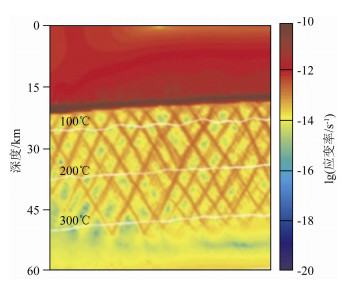
|
图 6 模型中局部放大的应变场图 Fig. 6 locally amplified strain field map in the model |
(2) 流体的渗流
构造应力在静力学和动力学两方面都影响着板块/岩石的渗透性(Sibson,1994).静力场使断裂或张裂缝处形成应力集中,并造成渗透的各向异性,从而影响渗透性.流体由于岩石在拉伸环境下的膨胀以及等压力变形而易于被压入到张性裂缝中.事实上,脆性张断裂中的应力往往要小于周边岩体(Mancktelow,2008),压力差的存在使得流体由周边岩体(高应力)向脆性断裂(低应力)中迁移.由这种压力差形成的流体迁移在地质上经常表现为含水矿物在断层带内的沉淀形成明显的晶体/矿物定向排列的现象(CPO).McLellan等(2004)用这种现象解释了热液矿物总是在断层带中产出的地质现象.脆性张断裂与周边岩体间的这种压力差引起的水分迁移在数值模型的模拟过程中也可以被观察到,表现为向下压入的孔隙水.
(3) 水化反应
水化反应是指水分由裂缝等渗流通道进入到板块/地质体后,与周边板块/地质体发生的的一种相互作用.这种相互作用,一方面湿润了与水分接触的周边板块/地质体;另一方面造成了周边板块/地质体体积及构造应力状态的改变而产生断裂或裂缝,促使水分进入到这些新的断裂或裂缝中形成新的接触面,产生新的水化反应.水化反应的上述性质大大加速了板块的水化速率(Jamtveit et al., 2000).超基性岩石中水化反应和蛇纹石化作用能使得其体积膨胀约50%,比如在偏光显微镜下可以看到橄榄岩(OI)由于水化及蛇纹石化作用产生的相互贯通的阶梯状/多变形状裂缝.这些由于水化反应/水分迁移造成的裂隙对水分迁移速率以及岩石矿物的沉积速率都起着重要作用(Iyer et al., 2008).
俯冲带水化的动力学过程可作为解释很多地球物理/地质现象的机制,例如上述的在板块上水分渗流通道的形成、热液矿产伴随断裂产出并沿断层方向发生明显的晶体/矿物定向排列现象,以及水化反应控制岩石中水分迁移及矿物沉积的速率等.
3.2 板块浅(中)部脱水含水板块(洋壳)向下俯冲的过程中,其所受到的温-压条件也相应发生变化,在逐渐升高的温度和压力下,含水板块中的水分析出的现象就是板块脱水.洋壳上部的孔隙水和在粘土及沸石中的弱结合水(H2O-)以及沉积物中的水分基本上在沉积增生楔和弧前盆地下部较浅处都已经排出(Staudigel et al., 1995).结构水(H2O+)将在更深处通过变质脱水作用析出.大部分脱水作用都受控于温度.因此,冷的板片的脱水发生深度将大于热的板片的脱水深度.如上所述,含水板块浅(中)部的脱水主要是析出孔隙水的过程,这已经被众多的地球物理观测数据所证实,例如俯冲带内低电阻率带(Worzewski et al., 2011),高纵/横波波速比(Vp/Vs)(Nakajima et al., 2011)以及双地震带(DSZ)的存在(Brudzinski et al., 2007).蛇纹石(13 wt.%H2O)、绿泥石(13 wt.%H2O)、滑石(4.8 wt.%H2O)、水镁石(31 wt.%H2O)和角闪石(2.1 wt.%H2O)是浅部(~50 km)和低压(P < 2 GPa)条件下高饱和橄榄岩的主要含水矿物.在深度大约为50~150 km(2 GPa < P < 5 GPa)处,绿泥石在蛇纹石分解后成为了最主要的含水矿物.在这一温-压条件下,一些中等-热的板块在500 ℃到800 ℃的温度下析出大量的水分(Hacker et al., 2003).对于一些冷的板块,水分可以被带到更深处(150~300 km).蛇纹石在P>5 GPa时,相变为相变阶段A(12 wt.%H2O),在压力为5~7 GPa,温度在600 ℃到700 ℃时,蛇纹石、绿泥石和滑石相变为相变阶段Å(13 wt.%H2O)(Fumagalli et al., 2001).室内高温-高压试验(Okamoto and Maruyama, 2004;Litasov and Ohtani, 2014)证明大部分板片(除了部分温度特别低的俯冲带,如西太平洋板块等)在300 km深度内已经全部脱水完成(Iwamori,2004;van Keken et al., 2011).因此,板块脱水大部分是发生在浅(中)部的,其具有如下一些重要的地球物理含义.
(1) 火山岛弧及弧后盆地的形成
图 7展示了板块浅部脱水的模型演化结果,从图中可以看到水分从洋壳、沉积物中析出,湿润周边的地幔物质并形成部分熔融.这部分的熔融物质上涌,在海沟前方造成火山弧地壳的抬升,并在该处发育较为强烈的岩浆作用,从而形成了火山岛弧,现今的日本群岛就是在这种机制下形成的(Turcotte and Schubert, 2002).这部分机制已经被广为接受,并有了众多的地质/地球物理证据,因此不再赘述.
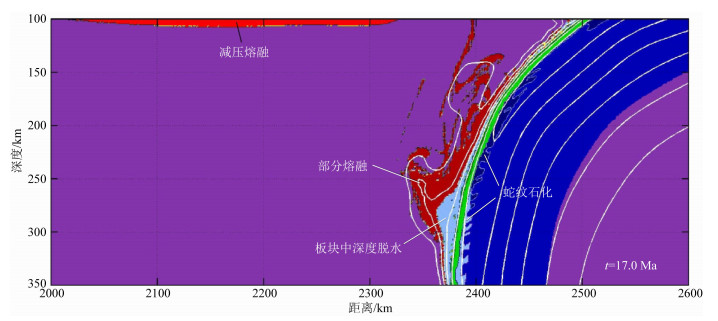
|
图 7 板块中部脱水过程模型演化结果 Fig. 7 Evolution of the dehydration process model in the middle of the plate |
弧后盆地的形成及发育过程主要受控于不同的俯冲机制,但是板块的浅(中)部脱水对于弧后盆地的发育同样有着至关重要的作用(Nakakuki and Mura, 2013;Sheng et al., 2018).水分不断在浅(中)部释放,使得新生的火山地壳由于水分作用产生的部分熔融而不断减薄,最后形成一个地幔物质得以发生减压熔融的颈状缺口,减压熔融导致缺口进一步扩展.颈状缺口的不断扩大降低了岩石圈的强度以及洋壳(俯冲板块)与陆壳(上覆板块)间的耦合,导致了俯冲在负浮力作用下开始后撤,陆壳被迫伸展以填补由于洋壳后撤形成的空区,形成了弧后扩展(图 8)(Turcotte and Schubert, 2002).海洋板块继续向下俯冲的主要驱动力是其受到的负浮力,主要的阻力来自于板块抵抗弯曲的张力和洋壳俯冲与地幔物质间的摩擦力(Funiciello,2003),在板块俯冲过程中阻力的增大速率远小于负浮力,直到洋壳俯冲到~660 km相变面,洋壳受到了新的阻力为止.在这一过程中,板块俯冲和后撤的速度持续增大,加快了陆壳的伸展,使其下部产生显著的减压熔融.地表处观察到的类似于洋中脊玄武岩(MORB)的弧后盆地玄武岩(BABB)就是由浅(中)部脱水产生的部分熔融和弧后扩展的减压熔融所形成的.

|
图 8 弧后盆地初始阶段模型演化结果(图中白色的箭头代表速度场) Fig. 8 Evolutionary results of the initial stage model of the post-arc basin (the white arrow in the figure represents the velocity field) |
(2) 低速异常带的存在
多种地球物理探测方法观测到在俯冲板块上存在一个厚约2~10 km的低波速带(LVL)(Matsuzawa et al., 1986;Tsuji et al., 2008).这个低速带是在板块脱水过程中产生的高压孔隙水湿化蓝闪石、硬柱石(Chantel et al., 2012;Mookherjee and Bezacier, 2012)、干的辉长岩(Hacker et al., 2003)而形成的,常被作为俯冲板块中变质玄武岩被水化的证据(Shiina et al., 2013).纵波波速(Vp)在这个低速异常带中降低5%到8%(日本东北部),甚至可以降低14%(尼加拉瓜).低速异常带常伴随出现高纵/横波速比(Vp/Vs)带,其范围大致为40~150 km,这和试验室内得到的板块脱水主要发生在300 km深度以内的结果是一致的.
另一方面,地震层析成像技术观测到在日本东北、中美洲以及智利北部下方中深度地幔中存在波速降低和高纵/横波速比(Vp/Vs)现象,推测这一现象和10%~20%蛇纹石化或俯冲板块在浅(中)部脱水析出的自由水有关(Dorbath et al., 2008;Syracuse et al., 2008).在新西兰北部岛屿和日本伊豆—小笠原海沟下方的太平洋板块上部(120~180 km)发现平行于海沟的各向异性带(Eberhart-Phillips and Reyners, 2009;Yu and Wang, 2013),超过该深度之后各向异性带发生减弱或歼灭.这种与深度相关的各向异性带不能用老构造伸展或板块弯曲变形形成B型橄榄岩构造来进行解释,它的解释需要一种黏-弹性随深度变化的机制,而板块浅(中)部脱水作用可以较好地解释这一现象(Huang et al., 2011).
(3) 对~410 km不连续带的影响
水分可以加速橄榄石到瓦兹利石以及尖晶橄榄石到钙钛矿相/方镁石相转化的动力学过程.在~410 km不连续带附近,大量的矿物(尖晶橄榄石和瓦兹利石)可以在其构造内含有大量的水分(高达3 wt.% H2O),而其上、下地幔物质的水溶性非常低.存在于地幔中部由俯冲板块脱水析出的水分被尖晶橄榄石和瓦兹利石所吸收,对~410 km不连续带形成的作用要大于温度差异的作用(Litasov et al., 2005).根据高温试验(Litasov and Ohtani, 2014),如果只考虑水分的影响,~410 km不连续带应该在压力更低(1~2 GPa)的地方出现,也就是大约在30~60 km的深度.当然,由于克拉伯龙斜率(Clapeyron′s slopes)在不同地震数据中的不确定性,目前分辨水分和温度对~410 km不连续带在地震层析成像资料上形成的异常还存在困难.
板块中部的脱水量对~410 km不连续带的反射率及层析成像形态有着很大的影响.如果水分充足,将会促进前期的熔融导致形成厚的橄榄岩-瓦兹利石转换带,如果板块脱水不充分,这个不连续带将会很薄(< 40 km)(Huang and Zhao, 2006).如果~410 km不连续带充分水化,将会形成厚约7 km的熔融带,这些熔融物质将会是地幔柱的部分来源(Chen et al., 2002).
3.3 板块深部脱水很多研究认为板块中所含有的水分基本都会在浅(中)部被排出,不可能在高温-高压条件下被俯冲板块带入到地幔深部.在一些较老和较冷的大洋岩石圈板块中,蛇纹石化作用可以发生在洋壳内部较深处(~40 km的深度内)(Li and Lee, 2006).English等(2003)认为俯冲过程中洋壳的表面会由于周边地幔物质的加热作用最先发生脱水,而蛇纹石化的板块内部,相比表面加热作用缓慢,因此脱水作用发生较晚.Stalder和Ulmer (2001)发现斜硅镁石(2.9 wt.%H2O)可以将水分稳定的保存到1100 ℃和14 GPa的高温高压环境中.这说明流体/水分可以被保存到~410 km不连续带以下,在压力大于12 GPa时,斜硅镁石处于相变阶段A以及相变到相变阶段E(11.4 wt.%H2O),当压力继续增大到15~17 GPa时,斜硅镁石从相变阶段E相变到超水相变阶段B(5.8 wt.%H2O).高含水镁硅酸盐(DHMS)相为相变阶段D(10~14 wt.%H2O),这个阶段可以保持到1200 km以下(Ohtani,2005).在较冷的板块中一系列的镁硅酸盐固-固相变,可以最终帮助高含水镁硅酸盐(DHMS)将水分带入地幔深部(Fumagalli et al., 2001).虽然在自然界中并未观察到含水镁硅酸盐(DHMS)的存在,并且由于地幔中瓦兹利石和尖晶橄榄石的高水溶性,含水镁硅酸盐(DHMS)可能也不会出现(Abgel et al., 2010),但是高含水镁硅酸盐(DHMS)还是给研究提供了一个水分运移到地幔深处的可能性.近期的研究(Ohtani et al., 2004)甚至认为DHMS相后还有一个H相,可以达到~60 GPa.虽然水分如何被保存/运移到地幔深处还存在着争议,但越来越多的研究认为俯冲板块是有能力将水分带入地幔深部,并在深部由板块脱水作用而释放出来(Brudzinski et al., 2007;Zhao and Ohtani, 2009;Sheng et al., 2016).在模型演化过程中,观察到了板块的深部脱水现象,水分从平卧在地幔深部的水化板块中析出,并受到地幔对流的影响发生对流扩散.析出的水分充分湿化平卧板块上部的地幔物质,致使这部分湿化的地幔物质的固液相限降低到与地温线相交,从而产生部分熔融(图 9).板块深部脱水可以较好地解释部分陆内火山(例如长白山)的成因(Zhao and Ohtani, 2009)、部分地区地幔柱的形成以及深源地震的发生(Omori et al., 2004).
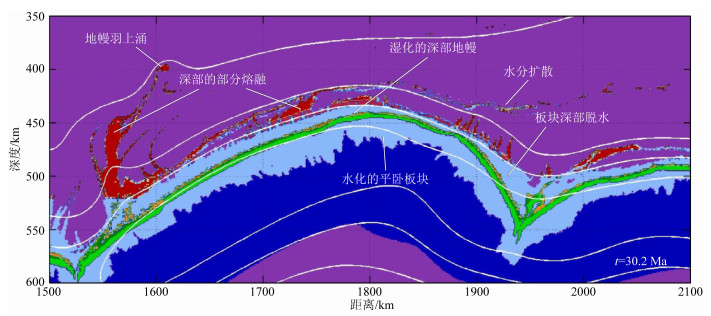
|
图 9 板块深部脱水过程模型演化结果 Fig. 9 Evolutionary results of the deep slabdehydration process model |
(1) 陆内火山作用
在亚欧大陆的东部有着500多座远离海沟(~1000 km)的内陆火山(刘嘉麒,1999),根据地震层析成像等手段的观测(Zhao and Ohtani, 2009;Zhao and Tian, 2013),太平洋板块平卧在这些火山~660 km的下方,因此,众多学者均认为这些火山的起源、发育以及活动与西太平洋板块—欧亚板块俯冲系统有关(Zhao et al., 2004;雷建设和赵大鹏,2004;刘若新等,1992;樊祺诚等,2007;马晗瑞,2016).然而,大部分俯冲带有关的火山(岛弧火山)都位于俯冲板块(洋壳)上方100 km左右,即使俯冲带角度会造成一定的影响,但这一深度也不会超过200 km.显然,这些火山不同于传统的俯冲带火山,应该属于内陆火山.Sheng等(2016)讨论多种机制的内陆火山成因,并根据数值模拟发现,俯冲板块深部脱水导致上覆地幔部分熔融进而产生岩浆作用是亚欧大陆东部这些火山成因的最为合理的解释,这一结果也得到了观测数据的支持(Zhao et al., 2004;雷建设和赵大鹏,2004;Zhao and Tian, 2013).从板块深部脱水的角度分析,根据模拟结果(图 3),洋壳(俯冲板块)通过蛇纹石化作用、高含水镁硅酸盐(DHMS)的相变等手段是有能力将水分带入~660 km的深度,并释放出来的.板块在深部脱水释放的水分,如果足够充足,将不会被洋壳自身的水化作用等完全消耗,而会向上运移并在陆壳下方聚集,从而导致部分熔融,进而形成岩浆房,引发陆内的火山/岩浆作用(Richard et al., 2006;Sheng et al., 2016;马晗瑞,2016).
(2) 拆沉板块深部脱水
板块拆沉后的残余板片平卧在~660 km相变面上经常可以在板块俯冲带被观测到(Wortel and Spakman, 2000;Chen and Brudzinski, 2001),在适当的温-压条件下,这些残余板片也将发生脱水作用而释放出水分(图 10),并造成其上部地幔物质的部分熔融.板块拆沉时间的早晚控制着拆沉的深度以及随着残余板片带入地幔深部的水分含量(Baumann et al., 2010;Duretz et al., 2011).从数值模拟模型演化的结果看,残余板片逐渐被周边地幔物质加热,从而发生脱水作用并析出水分,这些水分湿润了其上部的地幔物质,导致这些地幔物质由于固液相限降低到与地温线相交而发生部分熔融,这些熔融物质由于密度较周边物质要小,在浮力的作用下向上迁移,形成了地幔岩浆羽.这些地幔岩浆羽上升到某种程度上可以看作是地幔柱的一种成因方式.另外,从模型演化来看,这些上升的地幔岩浆羽加热了上覆板块,在某种条件下使得岩石圈减薄拉伸,在地表形成岩浆作用甚至诱发新的板块俯冲,比如Parece-Vela盆地(Funiciello,2003).

|
图 10 拆沉后的残余板片在深部脱水过程模型演化结果 Fig. 10 Evolutionary results of the dehydration process of the residual plate after detachment |
(3) 深源地震
关于我国东北深源地震与太平洋板块的关系存在争议.Shen and Zhou(2009)认为这些深源地震可能与锡霍特阿林大断裂处的俯冲带有关,他们认为太平洋板块由于受到下地幔的高温高压影响不可能被俯冲到远离海沟1200 km、深度大于600 km的位置引发地震,然而地球物理方法确实观测到了太平洋板块俯冲到了这一位置(Zhao et al., 2004;雷建设和赵大鹏,2004;Zhao and Tian, 2013).因此,大部分学者认为我国东北的深源地震受太平洋板块的影响(张凤鸣等,2007;马铭志等,2006).段永红等(2005)认为这一影响可能是间接的,西太平洋板块俯冲到欧亚板块下方,前端裂解为多个断块,并与欧亚板块下方的地幔物质相互碰撞、磨擦生热,发生塑性剪切并产生不均匀应力,使板块处相对较冷的部位发生破裂而产生地震.除此之外,对于深源地震的发震机理也存在分歧:包括脱水致裂(Raleigh and Paterson, 1965)、剪切不稳定性和熔融(Karato et al., 2001)以及亚稳态的橄榄石相变致裂(Green,2003;赵素涛等,2012;马晗瑞,2016).
在模型的演化结果中可以看到板块在深部存在着脱水现象(图 9).Omori等(2004)发现深源地震与含水镁硅酸盐相(DHMS)和氢氧镁石的分解有关,提出板块脱水将导致俯冲板块橄榄岩发生地震的假说(Green,2003;赵素涛等,2012).另外,从图 9上还可以观察到俯冲板块在地幔转换带深度有裂隙或断裂存在.这些裂隙或断裂可能是由于俯冲到达一定深度时,以结构水形式存在于无水矿物(NAMs)中的水不稳定脱出,使板块脱水致裂(断层)所造成的.脱水致裂的过程所释放的能量可能会诱发深源地震(Raleigh and Paterson, 1965).同时,脱出的水降低了上覆地幔物质固液相限,引起部分熔融并逐渐产生岩浆和陆内火山作用,这可能是我国东北地区深源地震与火山活动表现出相关性的原因(马晗瑞,2016).Karato等(2001)认为深源地震和俯冲板片剪切不稳定性与发生部分熔融有关,而水分的存在是深部发生部分熔融的重要条件.综上,板块深部脱水至少是大部分深源地震的成因之一.
4 结论本文以我国东北地区为例,通过模拟西太平洋板块向欧亚大陆俯冲的整个动力学过程,研究板块俯冲过程中的水分运移的全过程.根据模拟结果,将水分的迁移过程分为三个阶段:洋壳水化、板块浅(中)部脱水、板块深部脱水.分别分析了板块俯冲过程中这三个连续的水分迁移阶段的地球动力学过程,并尝试探讨了其中地球物理学/地球化学的机制.结合板块俯冲过程中水分迁移动力学过程的模拟结果,分别从洋壳水化、板块浅(中)部脱水、板块深部脱水这三方面讨论板块俯冲过程中水分迁移的地球物理意义.对于洋壳水化,揭示了水分渗流通道形成、水分渗流以及板块及地幔物质水化反应的机制;对于板块浅(中)部脱水,解释了其对火山岛弧、弧后盆地及低速异常带形成的作用,以及对~410 km不连续带的影响;对于板块深部脱水,从模型演化过程中观察到的板块深部脱水现象,推断出其存在发生的可能性,阐释了其与内陆火山(如亚洲东部的火山群,长白山等)形成、地幔柱(岩浆羽)产生及深源地震发生之间的关系.
Abgel R, Frost D, Ross N, et al. 2010. Stabilities and equations of state of dense hygrous magnesium silicates. Physics of the Earth and Planetary Interiors, 127: 181-196. |
Alt J, Honnorez J. 1984. Alteration of the upper oceanic crust, DSDP site 417:mineralogy and chemistry. Contributions to Mineralogy and Petrology, 87: 149-169. DOI:10.1007/BF00376221 |
Baitsch-Ghirardello B, Gerya T, Burg J. 2014. Geodynamic regimes of intra-oceanic subduction:Implications for arc extension vs. shortening processes. Gondwana Research, 25(2): 546-560. DOI:10.1016/j.gr.2012.11.003 |
Baumann C, Gerya T, Connolly J. 2010. Numerical modelling of spontaneous slab breakoff dynamics during continental collision. Geological Society, London, Special Publications, 332(1): 99-114. DOI:10.1144/sp332.7 |
Bittner D, Schmeling H. 1995. Numerical modelling of melting processes and induced diapirism in the lower crust. Geophysical Journal International, 123: 59-70. DOI:10.1111/j.1365-246X.1995.tb06661.x |
Brudzinski M, Thurber C, Hacker B, et al. 2007. Global prevalence of double Benioff zones. Science, 316(5830): 1472-1474. DOI:10.1126/science.1139204 |
Chantel J, Mookherjee M, Frost D. 2012. The elasticity of lawsonite at high pressure and the origin of low velocity layers in subduction zones. Earth and Planetary Science Letters, 349-350: 116-125. DOI:10.1016/j.epsl.2012.06.034 |
Chen J, Inoue T, Yurimoto H, et al. 2002. Effect of water on olivine-wadsleyite phase boundary in the (Mg, Fe)2SiO4 system. Geophysical Research Letters, 29. |
Chen W, Brudzinski M. 2001. Evidence for a large-scale remnant of subducted lithosphere beneath Fiji. Science, 292(5526): 2475-2479. DOI:10.1126/science.292.5526.2475 |
Clauser C, Huenges E. 1995. Thermal conductivity of rocks and minerals. Rock Physics & Phase Relations: A Handbook of Physical Constants, 105-126.
|
Contreras-Reyes E, Grevemeyer I, Watts A B, et al. 2011. Deep seismic structure of the Tonga subduction zone:Implications for mantle hydration, tectonic erosion, and arc magmatism. Journal of Geophysical Research, 116(B10). |
Connolly J. 2005. Computation of phase equilibria by linear programming:atoolfor geodynamic modeling and an application to subduction zone decarbonation. Earth and Planetary Science Letters, 236: 524-541. DOI:10.1016/j.epsl.2005.04.033 |
Connolly J. 2009. The geodynamic equation of state:what and how. Geochemistry, Geophysics, Geosystems, 10(Q10014). |
Crameri F, Schmeling H, Golabek G J, et al. 2012. A comparison of numerical surface topography calculations in geodynamic modelling:an evaluation of the 'sticky air' method. Geophysical Journal International, 189(1): 38-54. DOI:10.1111/j.1365-246X.2012.05388.x |
deMartin B, Hirth G. 2004. Experimental constraints on thermal cracking of peridotite oceanic spreading center. In: German, C. R., Lin J., Parson L. M. (Eds.), Mid-ocean Ridges: Hydrothermal Interactions Between the Lithosphere and Oceans.Geophysical Monograph. American Geophysical Union, Washington D. C.: 167-186.
|
Dorbath C, Gerbault M, Carlier G, et al. 2008. Double seismic zone of the Nazca plate in northern Chile:high-resolution velocity structure, petrological implications, and thermomechanical modeling. Geochemistry, Geophysics, Geosystems, 9. |
Duretz T, Gerya T V, May D A. 2011. Numerical modelling of spontaneous slab breakoff and subsequent topographic response. Tectonophysics, 502(1-2): 244-256. DOI:10.1016/j.tecto.2010.05.024 |
Duan Y, Zhang X, Liu Z, et al. 2005. A study on crustal structures of Changbaishan-Jingpohu volcanic area using receiver functions. Chinese Journal of Geophysics (in Chinese), 48(2): 352-358. |
Eberhart-Phillips D, Reyners M. 2009. Three-dimensional distribution of seismic anisotropy in the Hikurangi subduction zone beneath the central North Island, New Zealand. Journal of Geophysical Research, 114. |
English J, Johnston S, Wang K. 2003. Thermal modelling of the Laramide orogeny:testing the flat-slab subduction hypothesis. Earth and Planetary Science Letters, 214(3-4): 619-632. DOI:10.1016/S0012-821X(03)00399-6 |
Faccenda M. 2014. Water in the slab:A trilogy. Tectonophysics, 614: 1-30. DOI:10.1016/j.tecto.2013.12.020 |
Fan Q, Sui J, Li N, et al. 2007. The magmatism and interactive eruption of the two magma chambers in the Tianchi Volcano, Changbaishan. Bulletin of Mineralogy, Petrology and Geochemistry (in Chinese), 26(4): 315-318. |
Fumagalli P, Stixrude L, Poli S, et al. 2001. The 10Å phase:a high-pressure expandable sheet silicate stable during subduction of hydrated lithosphere. Earth and Planetary Science Letters, 186: 125-141. DOI:10.1016/S0012-821X(01)00238-2 |
Funiciello F. 2003. Dynamics of retreating slabs:2 Insights from three-dimensional laboratory experiments.. Journal of Geophysical Research, 108(B4). DOI:10.1029/2001jb000896 |
Gerya T, Meilick F. 2011. Geodynamic regimes of subduction under an active margin:effects of rheological weakening by fluids and melts. Journal of Metamorphic Geology, 29(1): 7-31. DOI:10.1111/j.1525-1314.2010.00904.x |
Gerya T, Yuen D. 2003. Characteristics-based marker-in-cell method with conservative finite-differences schemes for modeling geological flows with strongly variable transport properties. Physics of the Earth and Planetary Interiors, 140(4): 293-318. DOI:10.1016/j.pepi.2003.09.006 |
Gerya T, Yuen D. 2007. Robust characteristics method for modelling multiphase visco-elasto-plastic thermo-mechanical problems. Physics of the Earth and Planetary Interiors, 163(1-4): 83-105. DOI:10.1016/j.pepi.2007.04.015 |
Gorczyk W, Willner A, Gerya T, et al. 2007. Physical controls of magmatic productivity at Pacific-type convergent margins:Numerical modelling. Physics of the Earth and Planetary Interiors, 163(1-4): 209-232. DOI:10.1016/j.pepi.2007.05.010 |
Green H. 2003. Tiny triggers deep down. Nature, 424(6951): 893-894. DOI:10.1038/424893a |
Hacker B, Abers G, Peacock S. 2003. Subduction factory 1.Theoretical mineralogy, densities, seismic wave speeds, and H2O contents. Journal of Geophysical Research, 108(B1). DOI:10.1029/2001jb001127 |
Hess P. 1989. Origins of igneous rocks. Lodon, UK: Harward University Press.
|
Hirschmann M. 2000. Mantle solidus:Experimental constraints and the effects of peridotite composition. Geochemistry, Geophysics, Geosystems, 1(10): 1-26. |
Hofmeister A M. 1999. Mantle Values of Thermal Conductivity and the Geotherm from Phonon Lifetimes. Science, 283(5408): 1699-1706. DOI:10.1126/science.283.5408.1699 |
Huang J, Zhao D. 2006. High-resolution mantle tomography of China and surrounding regions. Journal of Geophysical Research, 111(B09305). |
Huang Z, Zhao D, Wang L. 2011. Frequency-dependent shear-wave slitting and multilayer anisotropy in northeast Japan. Geophysical Research Letters, 38. |
Ivandic M, Grevemeyer I, Bialas J, et al. 2010. Serpentinization in the trench-outer rise region offshore of Nicaragua:constraints from seismic refraction and wide-angle data. Geophysical Journal International, 180(3): 1253-1264. DOI:10.1111/j.1365-246X.2009.04474.x |
Iwamori H. 2004. Phase relations of peridotites under H2O-saturated conditions and ability of subducting plates for transportation of H2O. Earth and Planetary Science Letters, 227(1-2): 57-71. DOI:10.1016/j.epsl.2004.08.013 |
Iyer K, Jamtveit B, Mathiesen J, et al. 2008. Reaction-assisted hierarchical fracturing during serpentinization. Earth and Planetary Science Letters, 267: 503-516. DOI:10.1016/j.epsl.2007.11.060 |
Jamtveit B, Austrheim H, Malthe-Sørenssen A. 2000. Accelerated hydration of the Earth's deep crust induced by stress perturbations. Nature, 408: 75-79. DOI:10.1038/35040537 |
Johannes W. 1985. The significance of experimental studies for the formation of migmatites. In J. R. Ashworth (Ed.), Migmatites. Glasgow. London, UK: Springe.
|
Karato S. 1998. Some remarks on the origin of seismic anisotropy in the D″ layer. Earth Planetary Space, 50: 019-1028. |
Karato S I, Riedel M R, Yuen D A. 2001. Rheological structure and deformation of subducted slabs in the mantle transition zone:Implications for mantle circulation and deep earthquakes. Physics of the Earth and Planetary Interiors, 127: 83-108. DOI:10.1016/S0031-9201(01)00223-0 |
Katz R, Spiegelman M, Langmuir C. 2003. A new parameterization of hydrous mantle melting. Geochemistry, Geophysics, Geosystems, 4(9): 1-19. |
Korenaga J. 2007. Thermal cracking and the deep hydartion of oceanic lithosphere:a key to the genenration of plate tectonics?. Journal of Geophysical Research., B:Solid Earth, B05408: 1-20. DOI:10.1029/2006JB004502 |
Lei J, Zhao D. 2004. The relationship between the origin of the intraplate Changbai Volcano and the subducting Pacific slab. Advance in Earth Sciences (in Chinese), 19(3): 364-367. |
Li Z, Gerya T, Connolly J. 2019. Variability of subducting slab morphologies in the mantle transition zone:Insight from petrological-thermomechanical modeling. Earth-Science Reviews, 102874: 1-25. |
Li Z, Lee C. 2006. Geochemical investigation of serpentinized oceanic lithospheric mantle in the Feather River Ophiolite, California:Implications for the recycling rate of water by subduction. Chemical Geology, 235(1-2): 161-185. DOI:10.1016/j.chemgeo.2006.06.011 |
Li Z, Lee C, Peslier A H, et al. 2008. Water contents in mantle xenoliths from the Colorado Plateau and vicinity:Implications for the mantle rheology and hydration-induced thinning of continental lithosphere. Journal of Geophysical Research, B09210: 1-22. DOI:10.1029/2007JB005540 |
Liao J, Q Wang, T Gerya, M Ballmer. 2017. Modeling craton destruction by hydration-induced weakening of the upper mantle. Journal of Geophysical Research, 122(9): 7449-7466. DOI:10.1002/2017JB014157 |
Litasov K, Ohtani E. 2014. Effect of water on the phase relations in earth's mantle and deep water cycle. Geological Society of America Spacial Papers, 412(115): 156. DOI:10.1130/2007.2421(08) |
Litasov K, Ohtani E, Sano A, et al. 2005. Wet subduction versus cold subduction. Geophysical Research Letters, 32, L13312: 1-5. DOI:10.1029/2005GL022921 |
Liu J. 1999.Chinese Volcano, Beijing: Science Press (in Chinese), l3-111.
|
Liu R, Li J, Wei H. 1992. Volcano at Tianchi Lake, Changbaishan Mt.-A modern volcano with potential danger of eruption.. Chinese Journal of Geophysics (in Chinese), 35(5): 661-665. |
Ma H. 2016. Study on origin of the Tianchi Volcano, Changbaishan[Ph.D. dissertation] (in Chinese). Changchun: Jilin University.
|
Ma M, Liu T, Li X, et al. 2006. Discussion about the relationship between tectonic backgrounds of deep earthquake in Jilin Province and regional seismic energy anomaly. Seismological and Geomagnetic Observation and Research (in Chinese), 27(S1): 11-16. |
Mancktelow N S. 2008. Tectonic pressure:theoretical concepts and modelled examples. Lithos, 103: 149-177. DOI:10.1016/j.lithos.2007.09.013 |
Matsuzawa T, Umino N, Hasegawa A, et al. 1986. Upper mantle velocity structure estimated from Ps-converted wave beneath the north-eastern Japan Arc t. Journal of Geophysical Research Astron. Soc., 86: 767-787. DOI:10.1111/j.1365-246X.1986.tb00659.x |
McLellan J, Oliver N, Schaubs P. 2004. Fluid flow in extensional environments:numerical modeling with an application to Hamersley iron ores. J. Struct. Geol., 26: 1157-1171. DOI:10.1016/j.jsg.2003.11.015 |
Mei S, Kohlstedt D L. 2000a. Influence of water on plastic deformation of olivine aggregates:1. Diffusion creep regime. Journal of Geophysical Research, 105(B9): 21457-21469. DOI:10.1029/2000JB900179 |
Mei S, Kohlstedt D L. 2000b. Influence of water on plastic deformation of olivine aggregates:2. Dislocation creep regime. Journal of Geophysical Research, 105(B9): 21471. DOI:10.1029/2000JB900180 |
Mishin Y, Gerya T, Burg J-P, Connolly J. 2008. Dynamics of doublesubduction:numerical modeling. Phys. Earth Planet. Interiors, 171: 280-295. DOI:10.1016/j.pepi.2008.06.012 |
Mookherjee M, Bezacier L. 2012. The low velocity layer in subduction zone:structure and elasticity of glaucophane at high pressure. Earth and Planetary Science Letters, 208-209: 50-58. |
Nakajima J, Hasegawa A, Kita S. 2011. Seismic evidence for reactivation of a buried hydrated fault in the Pacific slab by the 2011 M9.0 Tohoku earthquake. Geophysical Research Letters, L00G06: 1-5. DOI:10.1029/2011GL048432 |
Nakakuki T, Mura E. 2013. Dynamics of slab rollback and induced back-arc basin formation. Earth and Planetary Science Letters, 361: 287-297. DOI:10.1016/j.epsl.2012.10.031 |
Ohtani E. 2005. Water in the mantle. Elements, 1: 25-30. DOI:10.2113/gselements.1.1.25 |
Ohtani E, Litasov K, Hosoya T, et al. 2004. Water transport into the deep mantle and formation of a hydrous transition zone. Physics of the Earth and Planetary Interiors, 143-144: 255-269. DOI:10.1016/j.pepi.2003.09.015 |
Ohtani E, Amaike Y, Kamada T, et al. 2014. Stability of hydrous phase H MgSiO4H2 under lower mantle conditions. Geophysical Research Letters, 41(23): 8283-8287. DOI:10.1002/2014GL06169 |
Okamoto K, Maruyama S. 2004. The Eclogite-Garnetite transformation in the MORB + H2O system. Physics of the Earth and Planetary Interiors, 146(1-2): 283-296. DOI:10.1016/j.pepi.2003.07.029 |
Omori S, Komabayashi T, Maruyama S. 2004. Dehydration and earthquakes in the subducting slab:empirical link in intermediate and deep seismic zones. Physics of the Earth and Planetary Interiors, 146: 297-311. DOI:10.1016/j.pepi.2003.08.014 |
Peacock S M. 1990a. Large-scale hydration of the lithosphere above sunbduting slabs. Chemical Geology, 108: 45-59. |
Peacock S M. 1990b. The importance of blueschist →eclogite dehydration reactions in subducting oceanic crust. Geological Society of America Bulletin, 105(5): 684-694. |
Poli S, Schmidt M. 2002. Petrology Ofsubductedslabs. Annual Review of Earth and Planetary Sciences, 30(1): 207-235. DOI:10.1146/annurev.earth.30.091201.140550 |
Raleigh C, Paterson M. 1965. Experimental deformation of serpentinite and its tectonic implications. Journal of Geophysical Research, 70: 3965-3985. DOI:10.1029/JZ070i016p03965 |
Ranalli G. 1995. Rheology of the Earth. UK: Springer.
|
Richard G, Bercovici D, Karato S. 2006. Slab dehydration in the Earth's mantle transition zone. Earth and Planetary Science Letters, 251(1-2): 156-167. DOI:10.1016/j.epsl.2006.09.006 |
Richard G, Iwamori H. 2010. Stagnant slab, wet plumes and Cenozoic volcanism in East Asia. Physics of the Earth and Planetary Interiors, 183(1-2): 280-287. DOI:10.1016/j.pepi.2010.02.009 |
Schmidt M, Poli S. 1998. Experimentally based water budgets for dehydrating slabs and consequences for arc magma generation. Earth and Planetary Science Letters, 163: 361-379. DOI:10.1016/S0012-821X(98)00142-3 |
Shen X, Zhou H. 2009. The low-velocity layer at the depth of 620km beneath Northeast China. Chinese Science Bulletin, 54(17): 3067-3075. DOI:10.1007/s11434-008-0559-z |
Sheng J, Liao J, Gerya J. 2016. Numerical modeling of deep oceanic slab dehydration:implications for the possible origin of far field intra-continental volcanoes in northeastern China. Journal of Asian Earth Science, 117: 328-336. DOI:10.1016/j.jseaes.2015.12.022 |
Sheng J, Li C, Liao J, et al. 2018. Dynamics of back-arc extension controlled by subducting slab retreat:insights from 2D thermo-mechanical modeling. Geological Journal, 2018: 1-13. DOI:10.1155/2018/3749725 |
Sheng J, Liao J, Li Y, et al. 2018. Influence of the Pacific plate subduction on the Tian-chi volcan. Chinese Journal of Geophysics (in Chinese), 61(11): 4396-4404. |
Shi Y, Zhang J. 1998. Thermal modeling of active ridge subduction and arc volcanism. Chinese Journal of Geophysics (in Chinese), 41(2): 174-181. |
Shi Y, Zhang J. 2004. Deep geodynamics of far field intercontinental back-arc extension formation of cenozoic volcanoes in Northeastern China. Acta Seismological Sinica (in Chinese), 26(S1): 1-8. |
Shiina T, Nakajima J, Matsuzawa T. 2013. Seismic evidence for high pore pressures in the oceanic crust:implications for fluid-related embrittlement. Geophysical Research Letters, 40: 2006-2010. DOI:10.1002/grl.50468 |
Sibson R. 1994. Crustal stress, faulting and fluid flow. Geichem. Soc. Spec. Publ, 78: 69-84. DOI:10.1144/GSL.SP.1994.078.01.07 |
Stalder R, Ulmer P. 2001. Phase relations of a serpntine composition between 5 and 14 Gpa:significance of clinohumite and phase E as water carriers into the transition zone. Contrib Mineral Petrol, 140: 670-679. DOI:10.1007/s004100000208 |
Staudigel H, Davies G, Hart S, et al. 1995. Large-scale isotopic Sr, Nd, and O isotopic anatomy of altered oceanic crust-DSDP/ODP site 417/418. Earth and Planetary Science Letters, 169-185. DOI:10.1016/0012-821X(94)00263-X |
Syracuse E M, Abers G A, Fischer K, et al. 2008. Seismic tomography and earthquake locations in the Nicaraguan and Costa Rican upper mantle. Geochemistry, Geophysics, Geosystems, 9(7): 1-22. DOI:10.1029/2008GC001963 |
Thybo H. 1997. The Seismic 8°Discontinuity and Partial Melting in Continental Mantle. Science, 275(5306): 1626-1629. DOI:10.1126/science.275.5306.1626 |
Turcotte D L, Schubert G. 2002. Geodynamics. Cambridge University Press.
|
Tsuji Y, Nakajima J, Hasegawa A. 2008. Tomographic evidence for hydrated oceanic crust of the Pacific slab beneath northeastern Japan:Implications for water transportation in subduction zones. Geophysical Research Letters, 35(14). DOI:10.1029/2008gl034461 |
van Avendonk H, Holbrook W, Lizarralde D, et al. 2011. Structure and serpentinization of the subducting Cocos plate offshore Nicaragua and Costa Rica. Geochemistry, Geophysics, Geosystems, 12(6): n/a-n/a. DOI:10.1029/2011gc003592 |
van der Lee S, Regenauer-Lieb K, Yuen D. 2008. The role of water in connecting past and future episodes of subduction. Earth and Planetary Science Letters, 273(1-2): 15-27. DOI:10.1016/j.epsl.2008.04.041 |
van Keken P, Hacker B, Syracuse E, et al. 2011. Subduction factory:4. Depth-dependent flux of H2O from subducting slabs worldwide. Journal of Geophysical Research, 116(B1). DOI:10.1029/2010jb007922 |
Vogt K, Castro A, Gerya T. 2013. Numerical modeling of geochemical variations caused by crustal relamination. Geochemistry, Geophysics, Geosystems, 14(2): 470-487. DOI:10.1002/ggge.20072 |
Vogt K, Gerya T V, Castro A. 2012. Crustal growth at active continental margins:Numerical modeling. Physics of the Earth and Planetary Interiors, 192-193: 1-2. DOI:10.1016/j.pepi.2011.12.003 |
Wang Z, Zhao D. 2005. Seismic imaging of the entire arc of Tohoku and Hokkaido in Japan by using P-wave, S-wave and sP depth-phase data. Phys. Earth Planet. Inter, 152: 144-162. DOI:10.1016/j.pepi.2005.06.010 |
Wang Z, Zhao D. 2006. Seismic evidence for the influence of fluids on the 2005 west off Fukuoka prefecture earthquake in southwest Japan. Phys. Earth Planet. Inter, 155: 313-324. DOI:10.1016/j.pepi.2006.01.006 |
Wang Z, Fukao Y, Miyakawa A, et al. 2019. Crustal extension and Graben Formation by fault slip-associated pore opening, Kyushu, Japan. Journal of Geophysical Research:Solid Earth, 124(5): 4879-4894. DOI:10.1029/2018JB016649 |
Wang Z, Kusky T, Capitanioac F. 2018. Water transportation ability of flat-lying slabs in the mantle transition zone and implications for craton destruction. Tectonophysics, 723(16): 95-106. |
Wortel M, Spakman W. 2000. Subduction and slab detachment in the Mediterranean-Carpathian. Science, 290(1910-1917). |
Worzewski T, Jegen M, Kopp H, et al. 2011. Magnetotelluric image of the fluid cycle in the Costa Rican subduction zone. Nature Geoscience, 4(2): 108-111. DOI:10.1038/ngeo1041 |
Yu D, Wang L. 2013. P-wave anisotropy tomography of central Japan:insight into subuduction dynamics. Tectonophysics, 592: 14-30. DOI:10.1016/j.tecto.2013.01.029 |
Zhang F, Zhang Y, Xv X, et al. 2007. Dynamic action on thesubduction movement of the west part of Japan Sea-deep focus earthquake region in Northeast area of China to the shallow source earthquake in northeast area. Seismological Research of Northeast China (in Chinese), 23(1): 33-39. |
Zhao D, Ohtani E. 2009. Deep slab subduction and dehydration and their geodynamic consequences:Evidence from seismology and mineral physics. Gondwana Research, 16(3-4): 401-413. DOI:10.1016/j.gr.2009.01.005 |
Zhao D, Tian Y. 2013. Changbai intraplate volcanism and deep earthquakes in East Asia:a possible link. Geophysical Journal International, 195(2): 706-724. DOI:10.1093/gji/ggt289 |
Zhao D, Lei J, Tang R. 2004. Origin of the Changbai intraplate volcanism in Northeast China:Evidence from seismic tomography. Chinese Science Bulletin, 49(13): 1401. DOI:10.1360/04wd0125 |
Zhao S, Jin Z, Gan W. 2012. A preliminary study of the focal mechanism of the deep-focus earthquakes in Northeast China. Earth Science Frontiers (in Chinese), 19(5): 300-311. |
段永红, 张先康, 刘志, 等. 2005. 长白山-镜泊湖火山区地壳结构接收函数研究. 地球物理学报, 48(2): 352-358. DOI:10.3321/j.issn:0001-5733.2005.02.017 |
樊祺诚, 隋建立, 王团华, 等. 2007. 长白山天池火山双岩浆房岩浆作用与互动式喷发. 矿物岩石地球化学通报, 26(4): 315-318. DOI:10.3969/j.issn.1007-2802.2007.04.001 |
雷建设, 赵大鹏. 2004. 长白山火山的起源和太平洋俯冲板块之间的关系. 地球科学进展, 19(3): 364-367. DOI:10.3321/j.issn:1001-8166.2004.03.003 |
刘嘉麒. 1999. 中国火山. 北京: 科学出版社, l3-111.
|
刘若新, 李继泰, 魏海泉, 等. 1992. 长白山天池火山-一座具有潜在喷发危险的近代火山. 地球物理学报, 35(5): 661-665. DOI:10.3321/j.issn:0001-5733.1992.05.016 |
马晗瑞. 2016. 长白山天池火山成因研究[博士论文]. 长春: 吉林大学.
|
马铭志, 刘铁男, 李雪梅, 等. 2006. 吉林深震的构造背景和区域地震能量的异常讨论. 大地震地磁与观测, 27(S1): 11-16. |
盛俭, 廖杰, 李永义, 等. 2018. 太平洋板块俯冲对长白山天池火山的影响. 地球物理学报, 61(11): 4396-4404. DOI:10.6038/cjg2018L0309 |
石耀霖, 张健. 1998. 活动海岭俯冲与岛弧火山活动的热模拟研究. 地球物理学报, 41(2): 174-181. DOI:10.3321/j.issn:0001-5733.1998.02.005 |
石耀霖, 张健. 2004. 中国东北远离海沟陆内弧后扩张形成新生代火山的深部地球动力学背景. 地震学报, 26(S1): 1-8. |
张凤鸣, 张亚江, 许晓艳, 等. 2007. 日本海西部-中国东北深震区俯冲运动对东北地区浅源地震的动力作用. 东北地震研究, 23(1): 33-39. DOI:10.3969/j.issn.1674-8565.2007.01.006 |
赵素涛, 金振民, 干薇. 2012. 中国东北深源地震机理. 地学前缘, 19(5): 300-311. |
 2021, Vol. 64
2021, Vol. 64


